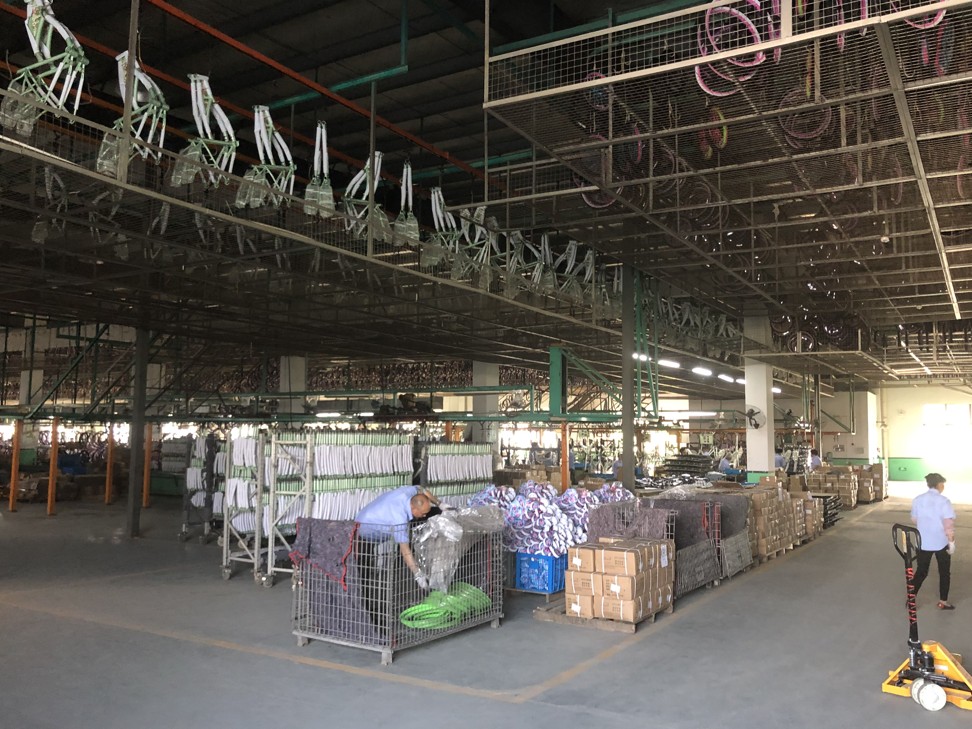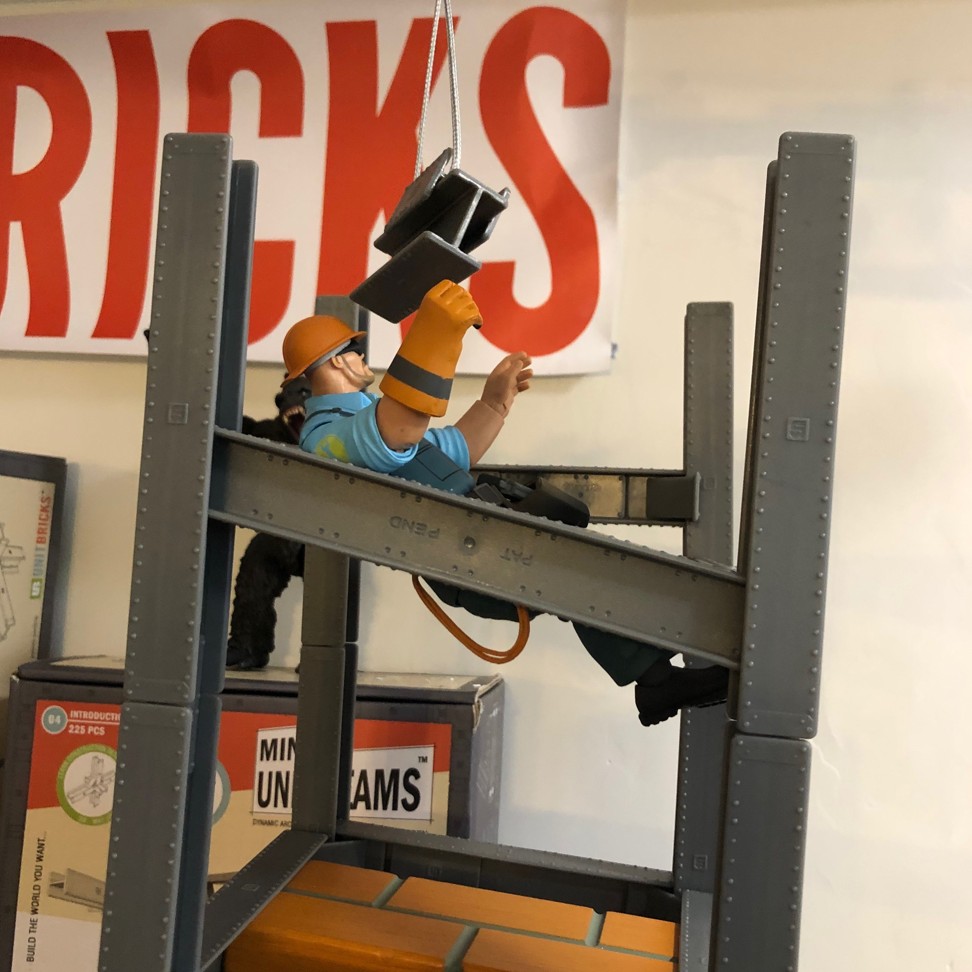
US-China trade war tariffs wreak havoc on Christmas orders with Chinese manufacturers thrown into disarray
- Chinese manufacturers would normally be expecting Christmas orders from US clients about now, but trade war uncertainty is forcing them to change plans
- Next round of tariffs from US President Donald Trump will include smartphones, toys and bicycles, with Chinese exporters saying US consumers will have to pay more
In a factory in Kunshan, an hour’s drive from downtown Shanghai, thousands of metal frames hang from a ceiling, their paint drying as they wait to become bicycles after wheels, handlebars, chains and other final parts are added to them.
This is one of seven production facilities that comprise the giant manufacturing plant of Shanghai General Sports, which produces 3 million bicycles each year, 2.4 million of which are exported to the United States.
In total, 16 per cent of the bicycles America imports from China each year are from the Kunshan factory, which houses a frantic mix of robotic arms and skilled human hands that paint, coat, assemble and package bicycles using components sourced from thousands of suppliers across China.
They enter the US under the Kent International brand, run by Arnold Kamler – a CEO who describes himself as a “student of the Chinese economy” and who affectionately refers to Ge Lei, the general manager of Shanghai General Sports as “like family”.
Usually, Ge is busiest in the run up to September, when the plant make millions of bicycles that eventually become Christmas presents or join retailers’ Black Friday inventories. Production usually ramps down thereafter – but not last year.
Between September – when US President Donald Trump slapped a 10 per cent tariff on bicycles and components from China – and the Lunar New Year at the start of February, Ge shipped 300,000 more bicycles to the US market than he usually would. Known as front-loading, this was the effect of retailers such as Walmart stockpiling in case the tariffs rose to 25 per cent – something which will now happen on June 1.
It means that for Christmas this year, Ge expects orders to be lower and US customers to have to spend more on bicycles than they would have in previous years.
“The number one impact is that the US has high inventory for the first half of this year. For the second half, we have not discussed it yet, but we feel we will export less,” Ge said.
The number one impact is that the US has high inventory for the first half of this year. For the second half, we have not discussed it yet, but we feel we will export less.
“If we assume the market has no change [in the number of orders], we will ship 300,000 fewer in the second half [given last year’s front-loading]. If the market drops by 10 per cent, we may ship a further 200,000 fewer. My short term goal is not to lose my market share in the US.”
While it may seem premature to think about Christmas, with summer just around the corner, many retailers and makers are now planning for the West’s busiest shopping season.
“For orders that have to be out by Christmas you have to plan for one month of shipping. Then retailers hold the stock for 30 days before they put it on the shelf. Production is up to 45 days. So that is more than three months,” said Jared Haw, the president of EPower Corp, a US contract manufacturer with facilities in Dongguan that make complex goods to order, from electric bicycles and “smart beehives”, to Fidget Cubes and Travel Tripods.
The latter two products resulted from crowdsourcing campaigns and had to be made from the prototype stage, meaning the lead time was even longer. “For brand new products where we have to open up tooling, it is probably going to be about five months,” Haw said.
The uncertainty around existing and incoming tariffs, along with the on-off nature of trade negotiations, has made life very difficult for Goldlok, a Guangdong-based toy manufacturer which has been exporting from China for 20 years.
Many of the company’s clients are American, and 40 per cent of those have been delaying making Christmas orders as they try to ride out the disruption to global trade, said Michael Yeung, Goldlok’s director.

March to May should have been peak ordering season for US buyers of the company’s toy trains, action figures, magnetic writing tools, dolls and water pistols, many of which end up as Christmas presents for American children.
“Our plans have suddenly been messed up. All Christmas products must be shipped to the US no later than September, otherwise no one will want them,” Yeung said.
If the new raft of 25 per cent tariffs are implemented in July, Yeung fears that customers will cancel existing orders, due to the higher costs. Even if the tariffs do not come into effect, those customers playing a “wait-and-see” game may lose out as the factory cannot deliver Christmas orders after August.
“If the tariff suddenly kicked in, the prices of ordered products would rise, our customers might not accept that,” he said. “Both the prices and the structure of our export products would be affected.”

Fully aware that Trump’s threat of implementing extra tariffs was hanging over the toy industry, Tim Scott-Stuart, the owner of educational toymaker Unit Bricks, decided to ship his Christmas orders earlier than normal this year.
Scott-Stuart’s business has been exporting out of China, Vietnam and Thailand for 15 years and the US is his largest market, accounting for around 75 per cent of all sales.
“We have not shipped yet, but plan to in the next week or two,” he said, adding that logjams at West Coast US ports were another reason to ship goods this month, also a by-product of the trade war. “Right now it looks like just the sheer volume is creating the back up, and this would be due to front loading to avoid potential tariffs. I would imagine,” he said.
The manufacturers are united in the view that the tariffs are bad for their business, but that the cost must be absorbed by the buyer and ultimately the consumer.
“Nobody on the supply chain can absorb additional tariffs,” Ge said in his Shanghai General Sports plant. “I don't know about other industries. For bicycles, we cannot share [tariffs with importers]. The margin is as thin as a piece of paper.”

Before the trade war, a 20-inch children’s bicycle, which cost US$40 at wholesale price, retailed at US$80. It has risen to US$90 per cent under the existing 10 per cent tariff, but will go to more than US$100 under the incoming 25 per cent.
“To be clear, China is not paying a penny of tariffs; rather, US companies and families are, through decreased profits and higher consumer prices,” said Steve Pasierb, president of the Toy Association, a US-based trade body.
However, the price is also being paid by Chinese manufacturers, many of which are making plans to leave the country. Ge bought land in Cambodia last year, as a contingency plan for the 25 per cent tariff.
“If you asked me four weeks ago, I was sure that they would not go to 25 per cent. So who knows? Really, moving to Cambodia is a big investment for us. We have waited for more than six months. So it does not matter, we can wait a little longer,” said Ge.



